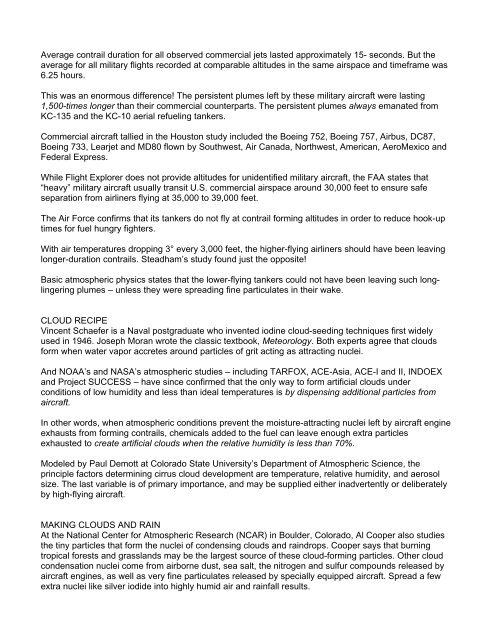CHEMTRAILS%20-%20CONFIRMED%20-%202010%20by%20William%20Thomas
CHEMTRAILS%20-%20CONFIRMED%20-%202010%20by%20William%20Thomas
CHEMTRAILS%20-%20CONFIRMED%20-%202010%20by%20William%20Thomas
Create successful ePaper yourself
Turn your PDF publications into a flip-book with our unique Google optimized e-Paper software.
Average contrail duration for all observed commercial jets lasted approximately 15- seconds. But the<br />
average for all military flights recorded at comparable altitudes in the same airspace and timeframe was<br />
6.25 hours.<br />
This was an enormous difference! The persistent plumes left by these military aircraft were lasting<br />
1,500-times longer than their commercial counterparts. The persistent plumes always emanated from<br />
KC-135 and the KC-10 aerial refueling tankers.<br />
Commercial aircraft tallied in the Houston study included the Boeing 752, Boeing 757, Airbus, DC87,<br />
Boeing 733, Learjet and MD80 flown by Southwest, Air Canada, Northwest, American, AeroMexico and<br />
Federal Express.<br />
While Flight Explorer does not provide altitudes for unidentified military aircraft, the FAA states that<br />
“heavy” military aircraft usually transit U.S. commercial airspace around 30,000 feet to ensure safe<br />
separation from airliners flying at 35,000 to 39,000 feet.<br />
The Air Force confirms that its tankers do not fly at contrail forming altitudes in order to reduce hook-up<br />
times for fuel hungry fighters.<br />
With air temperatures dropping 3° every 3,000 feet, the higher-flying airliners should have been leaving<br />
longer-duration contrails. Steadham’s study found just the opposite!<br />
Basic atmospheric physics states that the lower-flying tankers could not have been leaving such longlingering<br />
plumes – unless they were spreading fine particulates in their wake.<br />
CLOUD RECIPE<br />
Vincent Schaefer is a Naval postgraduate who invented iodine cloud-seeding techniques first widely<br />
used in 1946. Joseph Moran wrote the classic textbook, Meteorology. Both experts agree that clouds<br />
form when water vapor accretes around particles of grit acting as attracting nuclei.<br />
And NOAA’s and NASA’s atmospheric studies – including TARFOX, ACE-Asia, ACE-I and II, INDOEX<br />
and Project SUCCESS – have since confirmed that the only way to form artificial clouds under<br />
conditions of low humidity and less than ideal temperatures is by dispensing additional particles from<br />
aircraft.<br />
In other words, when atmospheric conditions prevent the moisture-attracting nuclei left by aircraft engine<br />
exhausts from forming contrails, chemicals added to the fuel can leave enough extra particles<br />
exhausted to create artificial clouds when the relative humidity is less than 70%.<br />
Modeled by Paul Demott at Colorado State University’s Department of Atmospheric Science, the<br />
principle factors determining cirrus cloud development are temperature, relative humidity, and aerosol<br />
size. The last variable is of primary importance, and may be supplied either inadvertently or deliberately<br />
by high-flying aircraft.<br />
MAKING CLOUDS AND RAIN<br />
At the National Center for Atmospheric Research (NCAR) in Boulder, Colorado, Al Cooper also studies<br />
the tiny particles that form the nuclei of condensing clouds and raindrops. Cooper says that burning<br />
tropical forests and grasslands may be the largest source of these cloud-forming particles. Other cloud<br />
condensation nuclei come from airborne dust, sea salt, the nitrogen and sulfur compounds released by<br />
aircraft engines, as well as very fine particulates released by specially equipped aircraft. Spread a few<br />
extra nuclei like silver iodide into highly humid air and rainfall results.


